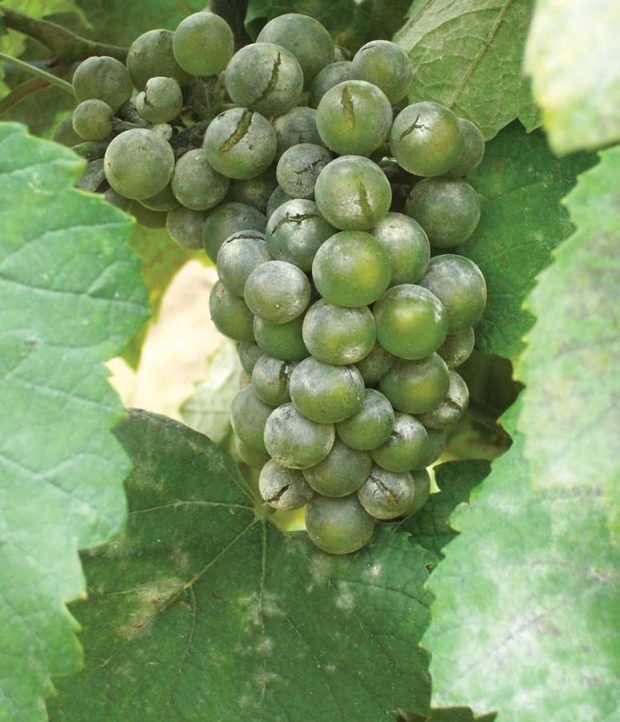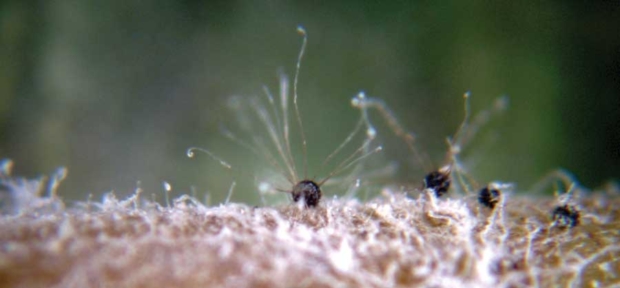
White grapes and leaves infected with powdery mildew. Researchers have found a reduced time frame for when grapes are susceptible to the disease, which allows growers to better focus their fungicide sprays. (Photos courtesy Washington State University)
Grape powdery mildew control programs, often requiring six to 10 fungicide applications, used to drag on for most of the growing season. Through research supported by the Washington State Wine Commission, growers have been able to shave off one or more fungicide sprays to save the industry more than $2 million annually.
Grape powdery mildew, a problem worldwide, can render a season’s worth of inputs and efforts into discarded cull fruit. Most Vitis vinifera varieties are susceptible to the disease.
Telltale symptoms are white or grayish coatings on green tissue, but other signs include dark lesions on green shoots, distorted young leaves and shriveled and cracked fruit.
Washington State University’s plant pathologist, Dr. Gary Grove, now director of the university’s Irrigated Agriculture Research and Extension Center in Prosser, Washington, spent much of his career working on the fungal pathogen, studying fungicide efficacy and optimum spray timing and developing disease resistance management strategies.
In the past, powdery mildew control programs were typically calendar-based, says Dr. Michelle Moyer, WSU extension viticulture specialist who has continued grape powdery mildew research.
“Growers used to spray every 10 to 15 days, depending on the choice of fungicide, disease pressure and the season,” she said. “At a minimum, seven sprays were usually made, sometimes nine. Now, growers can stop at five, and some are stopping at even less, depending on the year.”
Each fungicide application costs an average of $45 per acre, which includes material and the operator’s time but not the cost of the tractor and sprayer.
With an estimated 53,000 acres of wine grapes in Washington, each fungicide application represents nearly $2.4 million collectively spent by growers. On top of the cost, growers must carefully manage their fungicide program and rotate classes of fungicides to prevent development of resistance.
Key discovery

Cleistothecia is the primary source of inoculum for grapevine powdery mildew epidemics in eastern Washington. (Courtesy Washington State University)
One of the more useful scientific discoveries made by WSU was determining the pathogen’s life cycle in eastern Washington.
Grove found that cleistothecia (a structure of powdery mildew that swells and releases spores when temperatures are above 50 degrees Fahrenheit and there is 0.1 inch of rain) are the primary source of inoculum for powdery mildew epidemics in eastern Washington.
Cleistothecia overwinter in the bark of trunks and on leaf litter on the vineyard floor. That tidbit, combined with other research, has shaped Washington’s current control program.
WSU researchers found that the primary inoculum supply is exhausted by the end of bloom period. For years, grapes were thought to be susceptible from bloom through veraison, and spray programs reflected that belief. However, New York scientists demonstrated that grape berries developed resistance as they age — known as ontogenic resistance — and were only susceptible from pre-bloom until three to four weeks after fruit set.
In the mid-1990s, Grove worked with a powdery mildew risk index developed by University of California known as the Gubler-Thomas model.
Although the model helped industry interpret data and show that disease develops poorly during hot, dry weather, Grove said it was too conservative for eastern Washington growing conditions.
Timing
Moyer further explained that growers can delay disease progression in the vineyard and help clusters avoid infection by timing fungicides when fruit are most susceptible.
“Early vine development of around 6 inches of growth is typically coupled with spring rains — when infections start in the vineyard,” she said. “Spraying much before that likely won’t provide additional control in the vineyard and just cost you additional sprays.”
The ontogenic resistance of fruit at three to four weeks after fruit set indicates that sprays directed at keeping clusters free of disease can be slowed or stopped after that point.
“Fortunately for eastern Washington growers, this timing also typically coincides with 100-plus degree days with ample sunshine,” Moyer said. “This plant-based resistance, unfavorable weather conditions, and plant stress from deficit irrigation help keep mid- to late-season mildew at bay.”
Three sprays or less
Richard Hoff, director of viticulture for Mercer Canyons, a Prosser, Washington, wine producer, believes that growers have the upper hand in eastern Washington because of the region’s hot, dry climate, canopy style and irrigation management that results in open, airy canopies with controlled growth. Cultural practices that reduce vineyard humidity and encourage canopy air movement help manage the disease.
“Powdery mildew control programs are part science, part art because you have to factor in things like your canopy management style, current and forecasted weather patterns, and what type of disease pressure is in your area,” Hoff said. “Last year was so hot and so dry that I felt we could start our fungicide program at 9 inches of shoot growth instead of our usual 6 inches.”
Hoff applied only three fungicides on Mercer Canyon vineyards for powdery mildew last year (May 3, May 18 and June 3), with the exception of Riesling acreage that received four sprays. “In July, I was a little nervous,” he admitted. “But it turned out fine.”
Waiting until 9 inches of shoot growth is not something he would try in wet years like 2011. “I’d stay with 6 inches of shoot growth as a starting guide in wet years. But with our open canopies and deficit irrigation, most growers can easily get by with five sprays in a normal year.”
Some growers, like Paul Vandenberg, owner of Paradisos del Sol, a small family winery and vineyard in Washington’s Rattlesnake Hills appellation near Zillah, have been able to eliminate all fungicide and insecticide sprays. Vandenberg’s vines are trained to a modified trellis he described as a “horizontally divided, quadrilateral cordon” system, which keeps the canopy open, and he uses deficit irrigation to control vine vigor.
Hoff credits WSU research for helping growers know the critical timing of when to put on sprays, but also when to stop. WSU researchers have helped growers apply research knowledge (timing of initial infections, when fruit is most susceptible, and when mildew does not develop well during hot, dry conditions) to effectively develop their own weather and phenology-based spray models. •
– by Melissa Hansen, a research program manager for the Washington State Wine Commission and former associate editor with Good Fruit Grower.






Leave A Comment